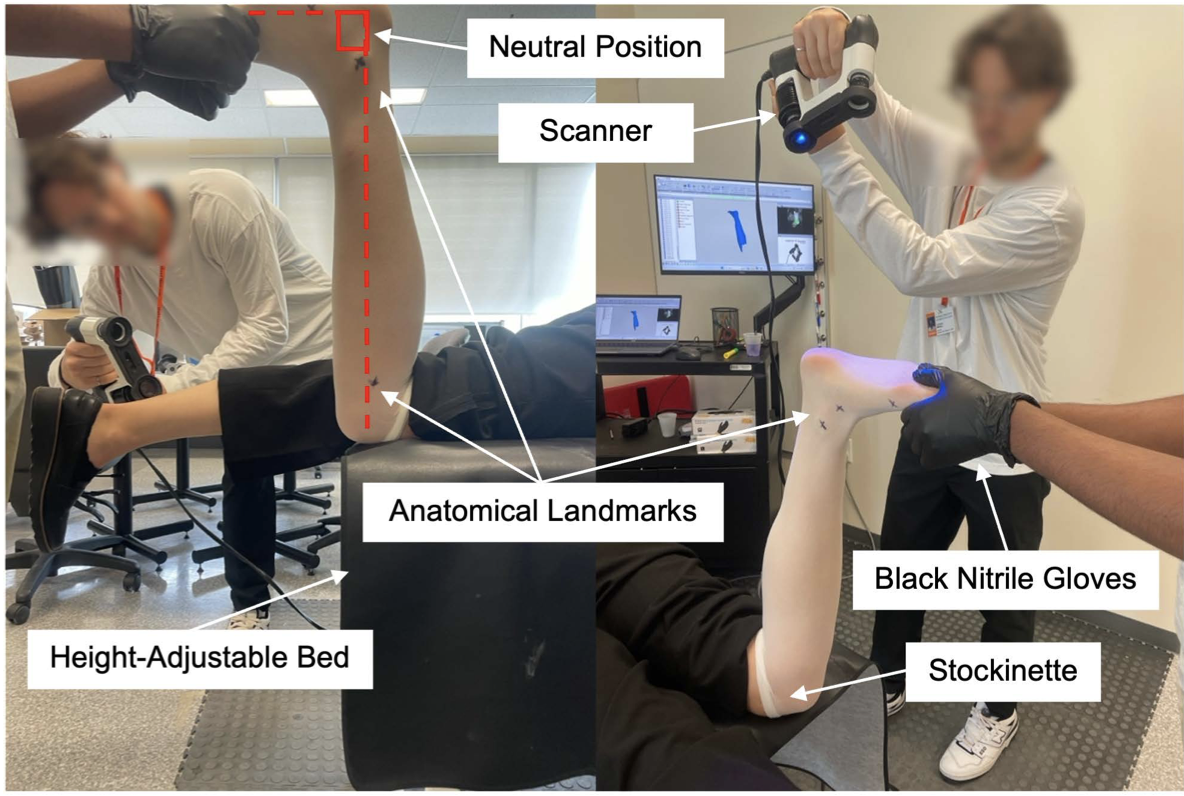Digital Tools Measure AFO Alignment Accurately
A study evaluating pediatric AFO alignment and shape differences of live scanned versus casted lower-limb models found that AFO users can be scanned in a nearly corrected position, and that digital tools can be used to measure and adjust ankle-foot alignment with high accuracy.

Fig 1. Scanning protocol for digital shape capture. https://doi.org/10.1371/journal.pone.0331895.g001
by The O&P EDGE September 12, 2025
Eighteen participants, four to16 years old, treated by five certified orthotists were recruited. Researchers scanned the participants and their casts and analyzed sagittal plane ankle-foot alignment differences between the models.
Using digital tools, the ankle-foot alignment of the live scans was then corrected, and the alignment differences were reevaluated to assess the realignment methods and allow for further shape comparisons. After correction, modification maps were generated to assess the surface deviations between the live scans and cast models, and shape differences assessed with respect to participant characteristics.
The modification maps revealed that the live scans closely matched the cast models, with shape differences consistently observed in the foot and heel regions. Height, age, and foot length had moderate effects on shape differences, while significant differences were observed between orthotists.
The orthotists rated their satisfaction with the time required, ease of the process, and results of both traditional and digital shape capture on a scale of 1–5, with 1 indicating “not satisfied at all” and 5 indicating “very satisfied.” The mean satisfaction scores were 4.44, 4.33, and 4.17 for traditional shape capture and 4.06, 4.00, and 4.11 for digital shape capture.
No significant differences were found in the scores for ease of the process and results, but the data indicated a significant difference in the score for time required. The study’s authors wrote that further evaluation is needed to explore whether satisfaction or performance improves over time, acknowledging a learning curve with the new technology.
Source The O&P EDGE
| References |
| Further reading |
Efficacy of hinged and carbon fiber ankle-foot orthoses in children with unilateral spastic cerebral palsy and drop-foot gait pattern, Dobler F, Mayr R, Lengnick H, Federolf P, Alexander N. Prosthet Orthot Int. 2024 Aug 1;48(4):380-386. doi: 10.1097/PXR.0000000000000337. Epub 2024 Apr 5.
Stiffness and Deflection of Custom-Fit, 3D-Printed Ankle-Foot Orthoses During Walking, and the Influence of Anthropometric Variability, Brokamp JR, Pollard RS, Nail-Ulloa IE, Zabala ME. IEEE Trans Neural Syst Rehabil Eng. 2025;33:3346-3354. doi: 10.1109/TNSRE.2025.3602709.
Efficacy of ankle foot orthoses types on walking in children with cerebral palsy: A systematic review, Aboutorabi A, Arazpour M, Ahmadi Bani M, Saeedi H, Head JS. Ann Phys Rehabil Med. 2017 Nov;60(6):393-402. doi: 10.1016/j.rehab.2017.05.004. Epub 2017 Jul 13.
The effect of thickness variation on the rigidity of ankle foot orthoses provided to the NHS: A case for the need for quality control, Chatzistergos PE, Eddison N, Theodorakos I, Chockalingam N. Med Eng Phys. 2025 Oct;144:104404. doi: 10.1016/j.medengphy.2025.104404. Epub 2025 Jul 28.
Also see
Walk Trial Tests Wearable Gait Monitoring Systems The O&P EDGE
